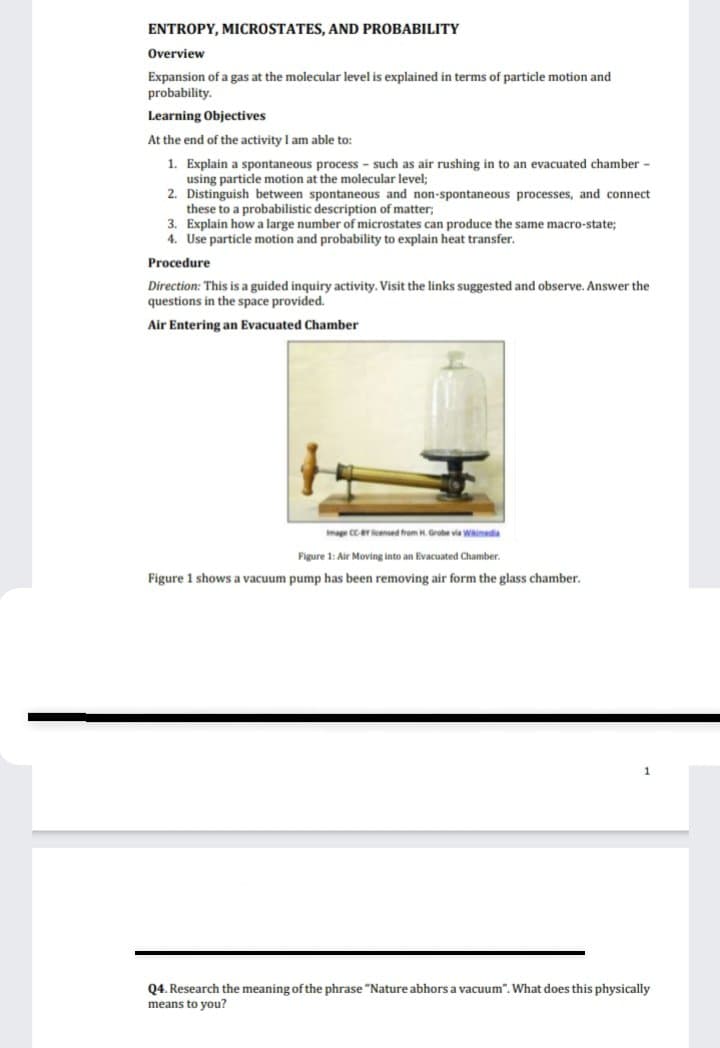ENTROPY, MICROSTATES, AND PROBABILITY Overview Expansion of a gas at the molecular level is explained in terms of particle motion and probability. Learning Objectives At the end of the activity I am able to: 1. Explain a spontaneous process - such as air rushing in to an evacuated chamber - using particle motion at the molecular level; 2. Distinguish between spontaneous and non-spontaneous processes, and connect these to a probabilistic description of matter; 3. Explain how a large number of microstates can produce the same macro-state; 4. Use particle motion and probability to explain heat transfer. Procedure Direction: This is a guided inquiry activity. Visit the links suggested and observe. Answer the questions in the space provided. Air Entering an Evacuated Chamber Image CC BY censed from H. Grobe via Wikimedia Figure 1: Air Moving into an Evacuated Chamber. Figure 1 shows a vacuum pump has been removing air form the glass chamber. Q4. Research the meaning of the phrase "Nature abhors a vacuum". What does this physically means to you?
ENTROPY, MICROSTATES, AND PROBABILITY Overview Expansion of a gas at the molecular level is explained in terms of particle motion and probability. Learning Objectives At the end of the activity I am able to: 1. Explain a spontaneous process - such as air rushing in to an evacuated chamber - using particle motion at the molecular level; 2. Distinguish between spontaneous and non-spontaneous processes, and connect these to a probabilistic description of matter; 3. Explain how a large number of microstates can produce the same macro-state; 4. Use particle motion and probability to explain heat transfer. Procedure Direction: This is a guided inquiry activity. Visit the links suggested and observe. Answer the questions in the space provided. Air Entering an Evacuated Chamber Image CC BY censed from H. Grobe via Wikimedia Figure 1: Air Moving into an Evacuated Chamber. Figure 1 shows a vacuum pump has been removing air form the glass chamber. Q4. Research the meaning of the phrase "Nature abhors a vacuum". What does this physically means to you?
Principles of Modern Chemistry
8th Edition
ISBN:9781305079113
Author:David W. Oxtoby, H. Pat Gillis, Laurie J. Butler
Publisher:David W. Oxtoby, H. Pat Gillis, Laurie J. Butler
Chapter13: Spontaneous Processes And Thermodynamic Equilibrium
Section: Chapter Questions
Problem 35P
Related questions
Question
Q4

Transcribed Image Text:ENTROPY, MICROSTATES, AND PROBABILITY
Overview
Expansion of a gas at the molecular level is explained in terms of particle motion and
probability.
Learning Objectives
At the end of the activity I am able to:
1.
Explain a spontaneous process - such as air rushing in to an evacuated chamber -
using particle motion at the molecular level;
2. Distinguish between spontaneous and non-spontaneous processes, and connect.
these to a probabilistic description of matter;
3. Explain how a large number of microstates can produce the same macro-state;
4. Use particle motion and probability to explain heat transfer.
Procedure
Direction: This is a guided inquiry activity. Visit the links suggested and observe. Answer the
questions in the space provided.
Air Entering an Evacuated Chamber
Image CC-BY licensed from H. Grobe via Wikimedia
Figure 1: Air Moving into an Evacuated Chamber.
Figure 1 shows a vacuum pump has been removing air form the glass chamber.
Q4. Research the meaning of the phrase "Nature abhors a vacuum". What does this physically
means to you?
Expert Solution
This question has been solved!
Explore an expertly crafted, step-by-step solution for a thorough understanding of key concepts.
Step by step
Solved in 3 steps with 4 images

Knowledge Booster
Learn more about
Need a deep-dive on the concept behind this application? Look no further. Learn more about this topic, chemistry and related others by exploring similar questions and additional content below.Recommended textbooks for you

Principles of Modern Chemistry
Chemistry
ISBN:
9781305079113
Author:
David W. Oxtoby, H. Pat Gillis, Laurie J. Butler
Publisher:
Cengage Learning

Chemistry for Engineering Students
Chemistry
ISBN:
9781285199023
Author:
Lawrence S. Brown, Tom Holme
Publisher:
Cengage Learning

Chemistry: The Molecular Science
Chemistry
ISBN:
9781285199047
Author:
John W. Moore, Conrad L. Stanitski
Publisher:
Cengage Learning

Principles of Modern Chemistry
Chemistry
ISBN:
9781305079113
Author:
David W. Oxtoby, H. Pat Gillis, Laurie J. Butler
Publisher:
Cengage Learning

Chemistry for Engineering Students
Chemistry
ISBN:
9781285199023
Author:
Lawrence S. Brown, Tom Holme
Publisher:
Cengage Learning

Chemistry: The Molecular Science
Chemistry
ISBN:
9781285199047
Author:
John W. Moore, Conrad L. Stanitski
Publisher:
Cengage Learning


Chemistry
Chemistry
ISBN:
9781305957404
Author:
Steven S. Zumdahl, Susan A. Zumdahl, Donald J. DeCoste
Publisher:
Cengage Learning

Chemistry: An Atoms First Approach
Chemistry
ISBN:
9781305079243
Author:
Steven S. Zumdahl, Susan A. Zumdahl
Publisher:
Cengage Learning